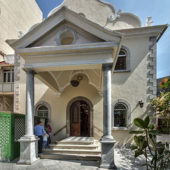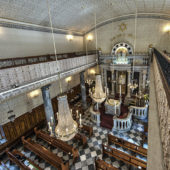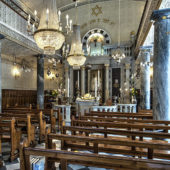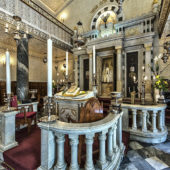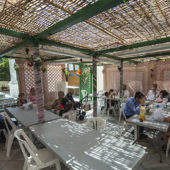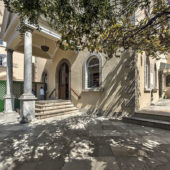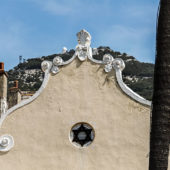The most ornate and lavish of Gibraltar’s synagogues.
Based on records that indicate a 1356 request for assistance in ransoming Jews that had been taken prisoner by pirates, it is known that Jews resided in Gibraltar as early as the 14th century. Gibraltar served as an exit gateway for many Jews who were expelled from Spain during the 1492 Spanish Inquisition. Jewish merchants from Italy, Amsterdam, London and Morocco were encouraged to settle in Gibraltar to provide provisions for the British military.
Isaac Nieto, a native of Livorno, Italy, went to London as a child when his father became chief rabbi of the Bevis Marks Synagogue. (displayed elsewhere on this website) In London the young Nieto received rabbinical training. He was one of the merchants who settled in Gibraltar. Nieto was the first rabbi of Gibraltar, naming his synagogue Shaar Hashamayim (Gate of Heaven). By the late 18th century many of the congregants felt that Moroccan traditions played too large a part in the synagogue’s services and customs. Some of the members chose to establish a new synagogue that would adhere more closely to the somewhat formal Dutch customs.
The breakaway group of Dutch merchants and Dutch origins built the Nefusot Yehuda Synagogue (English: The Dispersed of Judah), which opened in 1800. Borrowing stylistic design elements from the Amsterdam Sephardi Synagogue, this new place of worship came to be known as the Flemish Synagogue. A fire in 1913 destroyed the interior of the building. The architect who handled the interior reconstruction was an Italian who was familiar with Catholic church architecture. Thus, the Flemish Synagogue has its original Dutch exterior and an Italianate interior with marble, and a reading desk incorporated into the ark for the Torah, instead of being positioned in the center of the building. After 1945 Moroccan tiles were installed inside, accenting the ornately patterned ceilings and walls.

